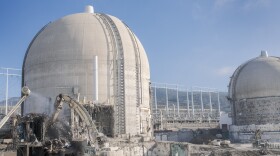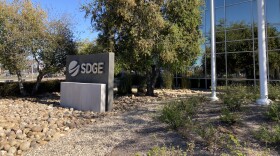We often figure fire burns randomly as it destroys one home but not another on the same street. But many fire experts say it’s more predictable than that: defensible space, building materials and an often forgotten issue plays a pivotal role. You guessed it: Location, location, location. Many fire experts say it’s the number one risk factor. Yet the Department of forestry says 5 million California homes are in wildfire-prone areas. And there’s little being done to limit development in such places.
One other thought: People cause 95 percent of wildfires. Critics say as we develop more into the wild lands, the farther out fires will start. They say firefighting costs are escalating out of control because we’re building into these high fire zones. And we all pay for that.
The land speaks to Skip and Linda Miller -- through silence, open space and majestic mountains.

|
Miller: Just being out here, look around, the mountains are beautiful and that’s what we wake up to every morning. No noise and just this.
Until last October, when fire roared through this Descanso valley. Fanned by 100 mile per hour Santa Anas, the McCoy fire devoured the Miller’s home.
Skip: I think we found everything we could, here’s a firesafe box.
Linda: Pretty fire safe.
This isn’t the first time flames took all they had. The Millers lost their house in the 2003 Cedar Fire. They had just re-built with fire-resistant materials, boxed eaves, no deck – everything you’re supposed to do in wildfire country. But fire got their home again.
We’ve been here for close to 30 years and never had to worry about a fire. When we had Cedar Fire we figured there wouldn’t be, you know everything is cleared, we wouldn’t have any problem for another 30 years. But we got a big surprise.
Llorente: We thought for sure the house was going to burn down.
Jorge Llorente got a different surprise last October, a most welcome one. When he and his wife returned to Rancho Santa Fe after the Witch Creek Fire, they expected what the Millers got. But their 1-year-old custom hacienda was untouched, except for some wilted plants and ashy pool water.
Llorente: There are five shelter-in-place communities and not a single home was destroyed in any of the five communities. And you can actually see the burns surrounded every one of the homes.
Llorente lives in the Cielo, one of the pricey subdivisions referred to as shelter-in-place. The nearly 2,500 houses have some of the most fire-safe building and landscaping requirements in the country -- standards that are vigorously enforced.
Rancho Santa Fe requires things the county doesn’t. Besides 100 feet of defensible space, Llorente can only use fire-resistant plants like this English lavender. And he had to build his home away from the top of the hillside, for reasons Cliff Hunter understands well.
Hunter: So when fire comes up from that draw, or that canyon it comes up with vengeance, a lot of heat and preheats what they have and catch it on fire and communicates it to the house and the house will burn down.
Tolin: So it’s not a big surprise to you that this home burned?
Hunter: Probably not. I would venture this house was built in the 60s to 70s.
The Witch Creek Fire burned 61 houses in Rancho Santa Fe. Fire Marshall Skip Hunter says they were all older – many built with wood shingles that easily ignite, single-paned windows that shatter from heat and open eaves vulnerable to embers. Hunter says new safeguards can prevent those things and don’t have to cost a lot. As for the name, Hunter says it’s misunderstood.
Hunter: In reality what it means is you shelter in place if you can’t evacuate, meaning the fire came with such speed you couldn’t get out safely. You’re safer to stay in your home than to try and evacuate and become a casualty on the roadway.
Although Rancho Santa Fe is stricter, San Diego County strengthened its building codes after the 2003 Cedar Fire. Now all new homes in the wildland-urban interface must have things like fire resistive walls made from stucco or cement, duel-paned windows and eves made from heavy timber.
Jacob: We do know that having strict building standards for new construction does make a difference.
County Supervisor Dianne Jacob says homes built with the new codes have a better chance. That’s important for her chaparral-covered East County district. A study of San Diego County shows three out of four homes are being built in the wildland urban interface – where open space and housing meet. Just since the Cedar Fire, 31,000 new homes have gone up in this highly flammable area. Shown here in yellow, the wildland urban interface is most vulnerable since fires usually start in the wildlands – depicted in green – and move to the urban interface where they spread easily. You can see from the burn areas, that’s exactly what happened in 2007.
The county governs how people build and landscape their properties, but so far its done little to restrict where they build, even though history shows some areas burn time and time again. Some fire experts say there’s no way to stop flames in areas like this, a high ridge top in the wildland urban interface.
Halsey: The fire starts coming up through this canyon here and starts shooting up right up through this draw and over that saddle and takes out all the homes at the top because that’s where all the heat is focused. It’s almost like a lens.
Chaparral Ecologist Rick Halsey says these Escondido homes on Bernardo Mountain were doomed, even with plenty of defensible space. As a trained firefighter, he applauds strict codes and shelter-in-place communities. But he fears they lull people into thinking its safe to build in danger zones.
Halsey: The worst place is the canyon or the saddle, the worst two rather, and they really should be legislated as now allowing any kind of development in those areas period. Put the park there, put the streets where they converge there, put the driveways there, just don’t put the house there!
Herzog: If some areas are really, really dangerous areas for fire, we might want to zone those in large estates so we don’t have very, very high density or medium density suburban type developments in those areas.
San Diego State Urban Planning Professor Larry Herzog says the county needs to link wildfire management with land use planning. It could prohibit large subdivisions in highly flammable areas, as Senator Dianne Feinstein advocated at a local hearing last November. But Herzog says pro-growth San Diego County has resisted this kind of zoning.
Herzog: We’re talking about a region where development and real estate growth is one of the major economic engines of our county. It’s a multi-billion dollar industry. Anything that smacks of regulation or holding back that development is a big threat to the private sector and also to government.
Rebecca: Developers want to build homes and residents want to buy homes and may not understand fire risk. Some people would say it is the government’s job to protect people from moving into those high risk fire areas.
Jacob: It’s also the government’s responsibility to protect private property rights. So while there is a public safety issue there is also an issue of private property rights. The key to me is to balance between those two.
Jacob says it’s not the government’s role to prohibit landowners from building in fire-prone areas. Besides, she believes, the whole county is in jeopardy. But Jacob says with the freedom to build, homeowners are assuming their own risk.
Miller: And the house would be in this area.
The Millers know the risks well. But they’re still planning to re-build on the 10 acres where they’ve lived for 30 years, raised four children and lost two homes.
Miller: I feel good about it. This is my home. I can’t go back to town.
The Millers accept their location is precarious, but its remote ruggedness is also what calls them back. This time around, Skip is researching an underground home. Think Lord of the Rings, San Diego style.
Skip: Shove it back into the hillside.
Tolin: So you want to build a house sort of like the Hobbit Home?
Skip: Yes, push some earth over top.
An earthen hideaway with metal shutters: perhaps they’ll outsmart the fire next time.
Linda: Now we get to start all over again.




